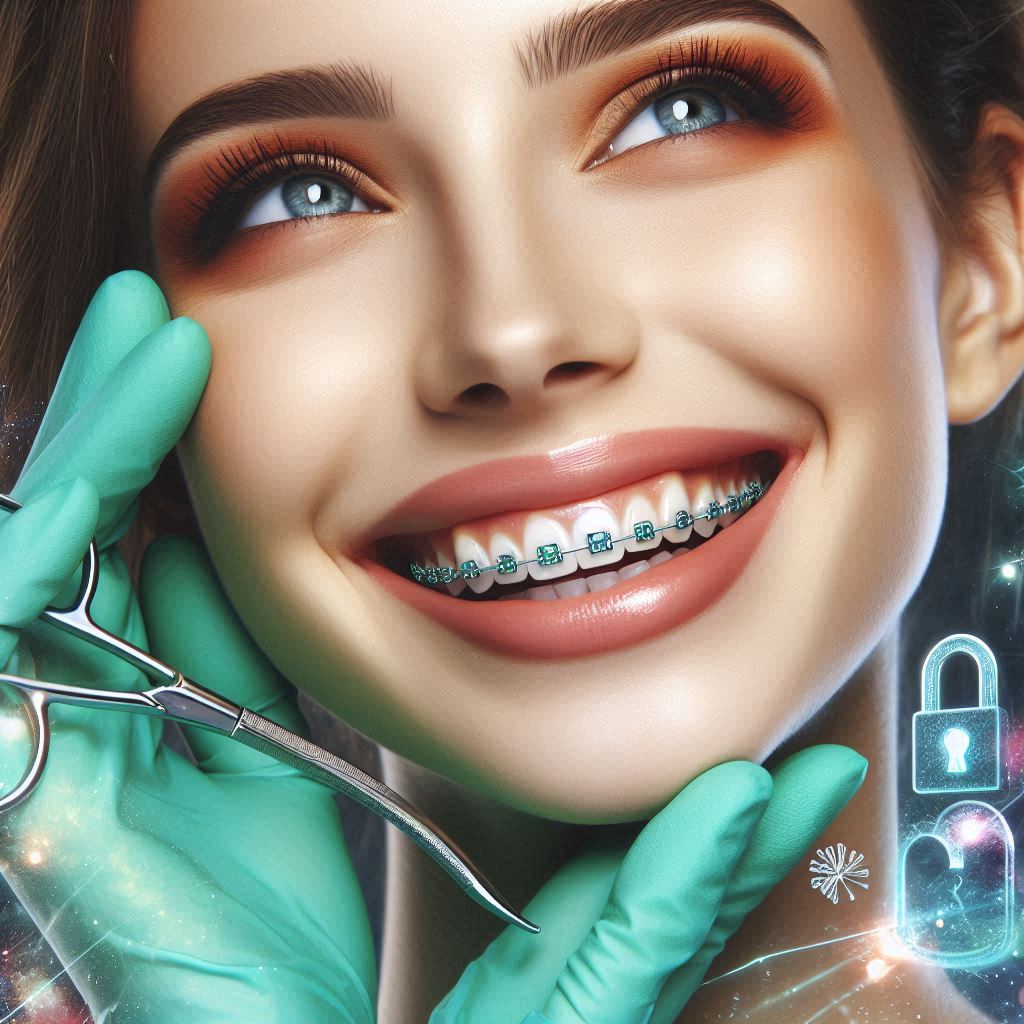Introduction
Orthodontics is a branch of dentistry focused on the diagnosis, prevention, and treatment of dental and facial abnormalities, primarily related to the alignment of the teeth and jaws. One of the most common reasons for orthodontic treatment is to improve the bite — the way the upper and lower teeth come together. Beyond just cosmetic enhancement, orthodontics plays a vital role in improving overall oral health, functionality, and the long-term preservation of your teeth.
When most people think about orthodontics, they envision braces, but orthodontic treatment can encompass a variety of appliances, from clear aligners like Invisalign to retainers, expanders, and other devices designed to correct misalignments and bite issues. Addressing these concerns early or later in life can have profound effects not only on your smile but also on your overall oral health, from preventing tooth decay and gum disease to reducing the risk of more severe dental complications.
In this article, we will explore how orthodontics can enhance the quality of life by improving your bite and promoting better oral health. We will cover topics ranging from the causes of misaligned bites to how orthodontics corrects these issues and the long-term benefits to oral health.
What is a Bite and Why is it Important?
A bite refers to the way your upper and lower teeth fit together when you close your mouth. The ideal bite is when the upper teeth slightly overlap the lower teeth, and the back teeth meet evenly to allow for proper chewing. This is known as a “normal” or “class I” bite. However, there are several types of bite misalignments, which include:
- Overbite (Deep Bite): Occurs when the upper front teeth excessively overlap the lower front teeth.
- Underbite: Occurs when the lower teeth overlap the upper teeth, leading to a protruding chin.
- Crossbite: Occurs when some of the upper teeth bite on the inside of the lower teeth.
- Open Bite: Occurs when there is a gap between the upper and lower teeth, preventing them from meeting when the mouth is closed.
- Crowding: Occurs when there is insufficient space in the mouth for all the teeth to fit properly, often resulting in overlapping teeth.
These misalignments can cause a range of issues that go beyond appearance. They can affect the way you chew, speak, and breathe, and, if left untreated, may lead to more serious dental problems down the line.
How Orthodontics Corrects Bite Problems
Orthodontics aims to correct these misalignments by using various devices that help reposition the teeth and jaw for proper alignment. There are multiple approaches to orthodontic treatment, each tailored to the individual patient’s needs, but they all share the common goal of improving function, appearance, and overall oral health. Here are some of the most common treatments used in orthodontics:
Braces
Braces are the most widely recognized orthodontic appliance. They consist of metal or ceramic brackets that are attached to the teeth, with wires running through them to gradually move the teeth into better alignment. Braces are particularly effective for more complex misalignments like severe overbites, underbites, and crossbites.
Braces work by applying continuous pressure to the teeth, which causes the bone around the teeth to gradually reshape. Over time, this pressure moves the teeth into their new positions. While braces are most commonly associated with teenagers, they can be used at any age. Modern braces are more discreet than ever, with options like clear ceramic braces or self-ligating braces that reduce discomfort and treatment time.
Invisalign
Invisalign is a popular alternative to traditional braces, particularly for adults or teens who prefer a more discreet option. This treatment uses a series of custom-made, clear plastic aligners that gradually move the teeth into place. The aligners are removable, allowing for easier brushing, flossing, and eating, making it an attractive choice for those with busy lifestyles or who dislike the appearance of traditional braces.
Invisalign is effective for many common orthodontic issues, including mild to moderate cases of overbite, underbite, and spacing issues. It offers a high level of comfort, and treatment times are often shorter than traditional braces, although this depends on the severity of the case.
Retainers
Retainers are used after the active phase of orthodontic treatment to maintain the position of the teeth. They help ensure that the teeth do not shift back to their original positions, which can occur if the teeth are not stabilized. Retainers are often worn for a period of time after braces or Invisalign treatment, and there are several types, including removable and fixed retainers.
Palate Expanders
For individuals with a narrow upper jaw, a palate expander can be used to gradually widen the jaw and create more space for the teeth. This device is commonly used in children whose bones are still developing, as it can help to prevent the need for tooth extractions later on. Palate expanders are typically worn for several months, depending on the severity of the jaw’s narrowness.
Headgear
Headgear is sometimes used in conjunction with braces to help move the teeth and jaw into the desired position. This device attaches to the braces and fits around the head or neck. It is generally used for specific cases, such as correcting overbites or underbites. Headgear is most commonly used for children and adolescents who are still growing, as it can help influence jaw development.
Other Appliances
In addition to the devices mentioned above, there are various other orthodontic appliances that may be used depending on the individual’s needs. These include space maintainers, which prevent teeth from shifting when baby teeth are lost prematurely, and elastics, which help correct bite issues by applying pressure to specific areas.
How Orthodontics Improves Your Oral Health
Correcting bite problems through orthodontic treatment can have a profound impact on your overall oral health. Here’s how orthodontics can help:
- Improved Oral Hygiene
Misaligned teeth are more difficult to clean properly, leading to an increased risk of plaque buildup and tooth decay. Crooked teeth can create hard-to-reach areas where food and bacteria accumulate, increasing the likelihood of cavities and gum disease. By straightening the teeth, orthodontics makes brushing and flossing easier, which leads to improved oral hygiene and a reduced risk of oral health problems.
- Prevention of Tooth Wear
When the teeth are not aligned properly, it can result in uneven wear on certain teeth. For example, teeth that are overcrowded or misaligned may make contact in unusual ways when chewing, leading to tooth wear, chipping, or cracking. By correcting bite issues, orthodontics can help distribute the forces of chewing evenly across the teeth, reducing the risk of tooth damage.
- Reduced Risk of Gum Disease
Gum disease (gingivitis and periodontitis) occurs when bacteria infect the gums, leading to inflammation, bleeding, and potential bone loss around the teeth. Misaligned teeth are more prone to plaque buildup, which can increase the risk of gum disease. By improving the alignment of the teeth, orthodontic treatment can make it easier to remove plaque and bacteria, thus lowering the risk of gum disease and preserving gum health.
- Prevention of Jaw Pain and TMJ Disorders
A misaligned bite can place unnecessary stress on the jaw joints, which can lead to temporomandibular joint (TMJ) disorders. TMJ disorders are characterized by pain, clicking, or popping in the jaw, headaches, and difficulty chewing. Orthodontic treatment can correct bite issues and reduce the strain on the jaw, helping to alleviate TMJ symptoms and prevent future discomfort.
- Better Chewing and Speech Function
Misaligned teeth can affect both chewing and speech. For instance, individuals with an overbite or underbite may have difficulty chewing certain foods, and those with an open bite may struggle to pronounce certain words clearly. Orthodontics can help correct these issues, allowing individuals to chew more effectively and speak more clearly, which can improve overall quality of life.
- Improved Aesthetics and Self-Esteem
While not a direct aspect of oral health, the cosmetic benefits of orthodontic treatment can significantly impact a person’s overall well-being. A straighter smile can boost self-esteem and confidence, encouraging individuals to smile more often and engage in social interactions. This positive emotional effect can have indirect benefits for mental and emotional health.
The Long-Term Benefits of Orthodontic Treatment
The benefits of orthodontics are not limited to the immediate improvements in bite and appearance. Long-term, orthodontic treatment can help maintain healthy teeth and gums throughout a person’s life. Some of the key long-term benefits include:
- Reduced Need for Future Dental Work: By correcting bite issues early, orthodontics can reduce the risk of future dental problems that would require extensive treatments, such as root canals, extractions, or crowns.
- Enhanced Quality of Life: By improving the function and appearance of the teeth, orthodontic treatment can contribute to a higher quality of life by improving chewing, speaking, and overall oral comfort.
- Preservation of Tooth Health: A properly aligned bite helps to distribute chewing forces evenly, preventing excessive wear on individual teeth, which can contribute to tooth sensitivity, cavities, and even tooth loss.
- Prevention of Jaw Issues: Addressing bite misalignments early on can help prevent the development of jaw-related issues, including TMJ disorders and chronic pain, which can be costly and difficult to treat once they develop.
The Importance of Early Orthodontic Intervention
While orthodontics can benefit people of all ages, early intervention in childhood can lead to more effective treatment and reduced need for extensive procedures later on. The American Association of Orthodontists recommends that children have their first orthodontic evaluation by the age of seven. Early treatment allows orthodontists to identify potential issues with tooth and jaw development before they become more complicated, and may even prevent the need for later, more intensive interventions.
Some of the common issues that can be addressed with early orthodontic intervention include:
- Crossbite: When the upper teeth bite inside the lower teeth, early correction can prevent uneven wear and gum recession.
- Overbite: In cases where the upper teeth significantly overlap the lower teeth, early treatment can guide proper jaw growth.
- Underbite: When the lower teeth protrude ahead of the upper teeth, early intervention can prevent jaw issues and improve facial appearance.
- Crowding: When the teeth lack sufficient space to erupt properly, early intervention can guide teeth into better alignment.
- Habits like Thumb-Sucking: Early intervention can help eliminate oral habits that might negatively affect dental development, like thumb-sucking or tongue-thrusting.
By addressing these concerns in childhood, orthodontic treatment can help achieve more predictable results, reduce the need for tooth extractions, and ensure that permanent teeth come in properly. Additionally, early intervention can prevent the development of more severe skeletal problems that may require surgical intervention later in life.
Factors Affecting the Success of Orthodontic Treatment
The success of orthodontic treatment depends on a variety of factors. While orthodontic appliances work in a similar manner for most patients, the effectiveness of treatment and the timeline for achieving optimal results can vary. Some factors influencing orthodontic outcomes include:
- Age of the Patient
As mentioned earlier, early treatment tends to yield more favorable outcomes, especially in younger children. This is because their bones and teeth are still developing, which means they are more adaptable to orthodontic forces. For older teens and adults, treatment may take longer, and in some cases, surgical interventions may be necessary to correct jaw-related issues. However, orthodontics can still be highly effective for adults, though the duration of treatment may vary based on the severity of the case.
- Severity of the Misalignment
The severity of the bite or alignment problem directly impacts the complexity of treatment. Mild cases of misalignment may only require the use of aligners or a few months of braces. However, more severe issues like significant overbites, underbites, or crossbites may require additional appliances or a combination of treatments. More complex issues may also involve surgical procedures to reposition the jaw.
- Compliance with Treatment Instructions
Whether you’re wearing traditional braces, clear aligners, or retainers, patient compliance is crucial for the success of orthodontic treatment. For braces, this means regularly visiting the orthodontist for adjustments and avoiding foods that can damage the braces. For Invisalign, it means wearing the aligners for the recommended 20-22 hours per day and following the treatment schedule. Failure to comply with treatment instructions can lead to delays in treatment, which can prolong the time required to achieve the desired results.
- Personal Oral Health
Maintaining good oral hygiene during orthodontic treatment is essential for optimal outcomes. As orthodontic appliances create more surfaces for food and plaque to accumulate, patients must commit to a thorough cleaning routine. Brushing and flossing at least twice a day, using specialized tools like interdental brushes or water flossers, and regularly visiting the dentist for cleanings will help ensure that teeth and gums remain healthy throughout the treatment process.
- Technological Advancements in Orthodontics
Advancements in orthodontic technology have significantly improved the efficiency and effectiveness of orthodontic treatment. Modern technology allows orthodontists to tailor treatments with greater precision and comfort. Some notable advancements include:
3D Imaging and Scanning: This technology provides a more accurate, detailed view of the patient’s teeth and jaw, helping orthodontists design more customized treatment plans.
Clear Aligners: As an alternative to traditional braces, clear aligners like Invisalign offer a discreet and comfortable option for patients seeking orthodontic care.
Self-Ligating Braces: These braces use a specialized mechanism to hold the wire in place, reducing the need for elastic bands and making adjustments quicker and more comfortable.
These advancements have made orthodontic treatment more effective, faster, and more comfortable than ever before.
Long-Term Care and Retention After Orthodontic Treatment
Orthodontic treatment doesn’t end once the braces or aligners are removed. After achieving the desired results, it’s essential to use a retainer to maintain the alignment of the teeth. This is because the teeth have a natural tendency to shift back to their original positions after treatment, particularly in the first few months following the removal of braces.
- Types of Retainers
Fixed Retainers: These are thin wires attached to the back of the teeth to keep them in place permanently. Fixed retainers are often used for the lower front teeth or for patients who are at a higher risk of teeth shifting.
Removable Retainers: These are clear, custom-made plastic devices that can be removed for eating, brushing, and flossing. They are typically worn for a period of time after treatment, gradually decreasing the number of hours worn as the teeth stabilize.
It’s essential to follow your orthodontist’s recommendations regarding retainer wear to ensure the long-term success of your treatment. Most patients are advised to wear their retainers full-time initially, then transition to wearing them only at night.
The Role of Orthodontics in Preventing Other Dental Problems
Orthodontics does more than just improve appearance and correct bite problems; it also helps prevent a range of other dental issues. Let’s take a closer look at how orthodontic care can contribute to overall dental health:
- Preventing Tooth Decay and Gum Disease
As mentioned earlier, misaligned teeth make it harder to maintain proper oral hygiene, increasing the risk of tooth decay and gum disease. By straightening teeth and improving their alignment, orthodontics makes it easier to clean the teeth and remove plaque buildup, reducing the risk of cavities and gingivitis. This is particularly important for people who may have difficulty brushing between crowded or crooked teeth, where plaque can accumulate more easily.
- Reducing the Risk of Tooth Grinding (Bruxism)
Tooth grinding, or bruxism, is a condition that involves clenching or grinding the teeth, often at night. It can lead to tooth wear, jaw pain, and even broken teeth. In many cases, orthodontic treatment can correct misaligned teeth and improve the bite, helping to alleviate or reduce the frequency of tooth grinding. By ensuring the teeth meet properly when biting, orthodontics can minimize the unnecessary stress placed on the teeth and jaw.
- Improving Jaw Function and Preventing Jaw Disorders
When the bite is misaligned, it can lead to jaw pain, discomfort, and even temporomandibular joint (TMJ) disorders. TMJ disorders involve pain, clicking, or popping in the jaw joint, as well as difficulty opening the mouth. By aligning the teeth and jaws correctly, orthodontics can alleviate the strain on the jaw and prevent or reduce the symptoms of TMJ disorders.
- Preventing Tooth Loss
Misaligned teeth can contribute to uneven wear, leading to the early breakdown of enamel and weakening of teeth. Over time, this can increase the risk of tooth loss, either due to cavities, gum disease, or fractures. Orthodontic treatment can help prevent this by ensuring that teeth meet properly and are supported by healthy gums, thus lowering the risk of premature tooth loss.
Conclusion
Orthodontics is not just about aesthetics; it plays a crucial role in improving overall oral health by correcting bite misalignments, ensuring proper tooth function, and preventing long-term dental problems. From enhancing oral hygiene to preventing tooth loss and improving jaw function, the benefits of orthodontic treatment extend far beyond achieving a beautiful smile. Whether you’re considering orthodontic treatment for yourself or your child, it’s essential to recognize the profound impact that orthodontics can have on your overall health and well-being.
By working with an experienced orthodontist, you can ensure that your treatment is tailored to your specific needs, providing long-lasting benefits that will improve both the appearance and functionality of your teeth and jaws.
SOURCES
American Association of Orthodontists. (2020). Early treatment for children.
American Dental Association. (2019). Orthodontics: What you need to know. https://www.ada.org/en/member-center/oral-health-topics/orthodontics
Birkeland, K., & Boe, O. (2004). Orthodontic treatment and quality of life. Acta Odontologica Scandinavica, 62(1), 29-35.
Gallego, P., Varela, M. A., & García, R. (2020). Impact of orthodontic treatment on dental health-related quality of life. The European Journal of Orthodontics, 42(5), 517-523.
Graber, T. M., Vanarsdall, R. L., & Vig, K. W. (2012). Orthodontics: Current principles and techniques (5th ed.). Elsevier Health Sciences.
Gulati, S., & Khanna, S. (2014). Role of orthodontics in the prevention of dental diseases. Journal of Orthodontic Research, 2(1), 23-27.
Joffe, L., & Sadowsky, C. (2004). Orthodontics and the treatment of malocclusions. Journal of Dental Research, 83(5), 348-352.
Kravitz, N. D., & Kusnoto, B. (2007). Risks and benefits of orthodontic treatment. The American Journal of Orthodontics and Dentofacial Orthopedics, 131(3), 313-318.
Lobbezoo, F., Ahlberg, J., & Manfredini, D. (2013). Bruxism: An overview of its clinical features and treatment modalities. Journal of Oral Rehabilitation, 40(11), 838-849.
Melsen, B. (2005). The role of orthodontics in the prevention of malocclusion and other dental problems. Journal of Clinical Orthodontics, 39(3), 162-168.
Pancherz, H., & Ngan, P. (2010). Treatment of class II malocclusion with headgear and functional appliances. The Journal of Clinical Orthodontics, 44(8), 473-481.
Parker, S. (2015). The importance of early orthodontic evaluation and treatment. Journal of the American Dental Association, 146(1), 9-12.
Proffit, W. R., Fields, H. W., & Moray, L. J. (2003). Contemporary orthodontics (3rd ed.). Mosby.
Sharma, A., & Lall, R. (2018). Orthodontics: Its role in dental health improvement and prevention. Journal of Orthodontics & Dentofacial Orthopedics, 2(1), 15-20.
Steiner, C. C. (2007). The cephalometric analysis for orthodontics. Journal of Orthodontic Science, 7(4), 230-237.
Thomas, P. M., & Williams, L. (2016). Braces vs. clear aligners: A comparative analysis. Journal of Clinical Orthodontics, 50(2), 115-121.
Warren, J. J., & Bishara, S. E. (2003). The role of orthodontics in the prevention of dental issues. International Journal of Pediatric Dentistry, 13(2), 89-94.
HISTORY
Current Version
February, 10, 2025
Written By
SUMMIYAH MAHMOOD




